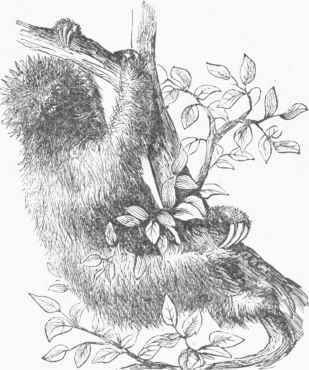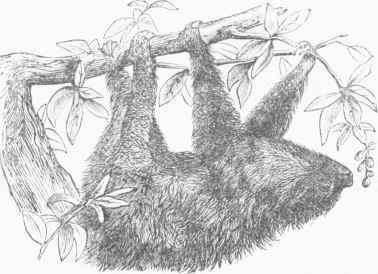Sloth
Description
This section is from "The American Cyclopaedia", by George Ripley And Charles A. Dana. Also available from Amazon: The New American Cyclopędia. 16 volumes complete..
Sloth
Sloth, the name of the edentate mammals of the family tardigrada (111.) and genus brady-pus (Linn.); both the family and generic names are derived from the extreme slowness of the gait; it is le paresseux of the French. The skull is small, rounded, flat, and truncated in front; the jaws very short and the face very little projecting beyond the line of the cranium; the malar bone gives off a zygomatic process which runs backward and passes above the corresponding one of the temporal bone without touching it, a second process descending outside the lower jaw, which is very strong. The fore legs are much longer than the hind, and all the toes end in long curved claws, channelled underneath, the bones firmly united together and the claws naturally turned in against the soles; the fore feet have either three or two toes, and the hind feet three toes; the latter are articulated obliquely on the leg, so that only the exterior edge touches the ground, of course making progression on a level surface very awkward; the pelvis is so wide and the thighs so laterally directed that the knees cannot be brought together. The ears are very short, and concealed under the hair, which is dry, harsh, and coarse.
The axillary and iliac arteries, instead of pursuing their usual course down the limbs as single vessels, suddenly subdivide into from 40 to 60 small trunks of equal size, freely anastomosing with each other, looking somewhat like a mass of varicose veins, and distributed chiefly to the muscles; the arrest of the circulation by pressure on a single trunk is thus prevented, and its retardation permits slow and long continued contraction of the muscles of the arms and legs. The stomach is divided into four cavities without folds, the intestine is short, and the caecum absent; the mamma) are two, and pectoral; there is a common cloaca, as in birds, for the expulsion of the urine and faeces. The dental formula is |:|, the teeth being simple, separated, nearly cylindrical, without roots, with an undivided hollow base continually growing as they are worn by use, and composed of dentine and cement without enamel; there are no incisors; the anterior molars are very small in the three-toed sloth, but in the two-toed are long, pointed, resembling canines, and the lower placed behind the upper. The tail is very short, or absent.
The sloths were considered by the early naturalists as imperfect and deformed creatures; but in the trees, their natural home, their peculiarities of structure are as admirably adapted for their convenience and enjoyment as in any other animal; the fore limbs have great freedom of motion, and all are so constructed that by means of the claws they suspend themselves to the branches and hang for a long time, and even sleep, back downward. They are rarely seen on the ground, for the reason that they can pass from one tree to another by the interlocking branches for miles in the thick forests of South America, which they inhabit from Guiana to Paraguay, some species extending to Peru, and according to some authors into Central America. They are rarely more than 2 ft. long, and their hair resembles in color the bark of the trees upon which they live; the food is entirely vegetable, the leaves and twigs of trees. They have one young one at a time, which clings to the mother's back, hiding among the hair; the native name is ai, from their feeble plaintive cry; they are remarkably tenacious of life, and apparently unconscious of pain. - Linnaeus gave the name of B. tridactylas to a three-toed sloth, under the impression that there was only one species thus characterized, whereas Wagner describes several in the Archiv far Naturgeschichte for 1850. The animal referred to by Linnaeus is grayish, with the body 14 in. long, the head about 3, the tail 1, the fore limb 11, the hind G, and the claws 2 to 2½; it has 9 cervical vertebrae, and 14 ribs on each side, of which 9 are true; the thumb and little finger are rudimentary and hidden under the skin; there is a rudimentary clavicle attached to the acromion; the hair is reversed on the forearm.
It has been calculated that it can take only 50 steps a day, consuming a month in traversing a mile; if by chance it ascends a tree too remote from another to admit of a passage across, the natives say that it rolls itself in a ball and drops to the ground, and the thick wiry hair would render such a fall comparatively harmless; from its habits it can rarely if ever drink; its flesh and skin are useless; in captivity it is exceedingly stupid and uninteresting. The unau or two-toed sloth (B. didactylus, Linn.; genus choloepus, Illig.) is mixed brown and white, paler below; it is about 2 ft. long, with, according to Daubenton, 23 ribs on each side, of which 12 are true; the clavicles are complete, and the tail is wanting; it has a longer muzzle and shorter fore legs than the three-toed species, and is more active, especially at night; it inhabits the same region, and is sometimes eaten by Indians and negroes. - For the fossil edentates, see Megalonyx, Megatherium, and Mylodon; for anatomical details, see Comparative Anatomy, and Edentata.

Three-toed Sloth (Brudypus tridactylus).

Unau or Two-toed Sloth (Bradypus didactylus).
Continue to:


